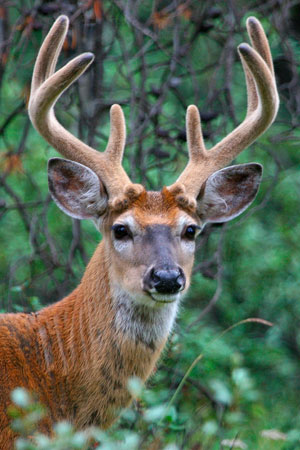

|
White-tailed Deer (Odocoileus virginianus) What they look like: White-tailed deer are the smallest members of the North American deer family. Adult white-tail deer have reddish-brown coats in summer. The color fades to a duller grayish-brown in winter. Male deer, called bucks, are easily distinguished in the summer and fall by their large set of antlers. New antlers are grown annually and fall off in the winter. "White-tailed" refers to the white underside of the deer's tail, which it displays and wags when it senses danger. These large mammals weigh 110 to 300 lbs (50 to 136 kg). White-tailed ears are considerably smaller than Mule Deer ears.
Deer prefer open woodland, but are often found on the fringes of urban areas and in farming country. White-tailed deer are found primarily east of the Cascade crest. White-tailed Deer habitat includes areas along streams and rivers, mixed woodlands, farms, forests, and burned shrub fields. Open areas are used only when thick shrubs or forest are nearby. Click the range map to learn more about the distribution of White-tailed deer in Washington. Then, compare the range of the White-tailed deer to the distribution of Mule deer in Washington.
What they eat: Whitetail deer feed on a variety of vegetation, depending on what is available in their habitat. In eastern forests, buds and twigs of maple, sassafras, poplar, aspen and birch are consumed, as well as many shrubs. Conifers are often eaten in winter when other plants become scarce. Behavior: Whitetail deer are the most nervous and shy of the deer in Washington. White-tail deer wave their tails characteristically from side to side when they are startled. They are very agile and may bound at speeds of up to 30 miles per hour through the forest. 
White-tailed females are very protective of their babies (fawns). When looking for food, females leave their offspring in a hiding place for about four hours at a time. While waiting for their mother to return, fawns lay flat on the ground with their necks outstretched, well camouflaged against the forest floor. Whitetail deer are generally solitary (live alone), especially in summer. The basic social unit is a female and her fawns, although does have been observed to graze together in large herds. Whitetail deer are crepuscular, feeding mainly from before dawn until several hours later, and again from late afternoon until dusk. They rest or are inactive during daylight hours. Reproduction: Antlers do not serve as weapons against predators, but are used during the mating season, when the males fight to breed with females. The bucks antlers are shed from January to March and grow out again in in the spring.
How long they live: Most white-tailed deer live about 2 to 3 years. The maximum life span in the wild is 20 years, but few deer live past 10 years old.
Did you know?

White-tailed Deer photo by Natures Pics More information: Odocoileus virginianus Information - Animal Diversity Web
|
Animal silhouettes available to purchase »
Photos: Natures Pics
Home | About Us | How to Participate | Biodiversity Modules | Projects | Maps | News | Resources